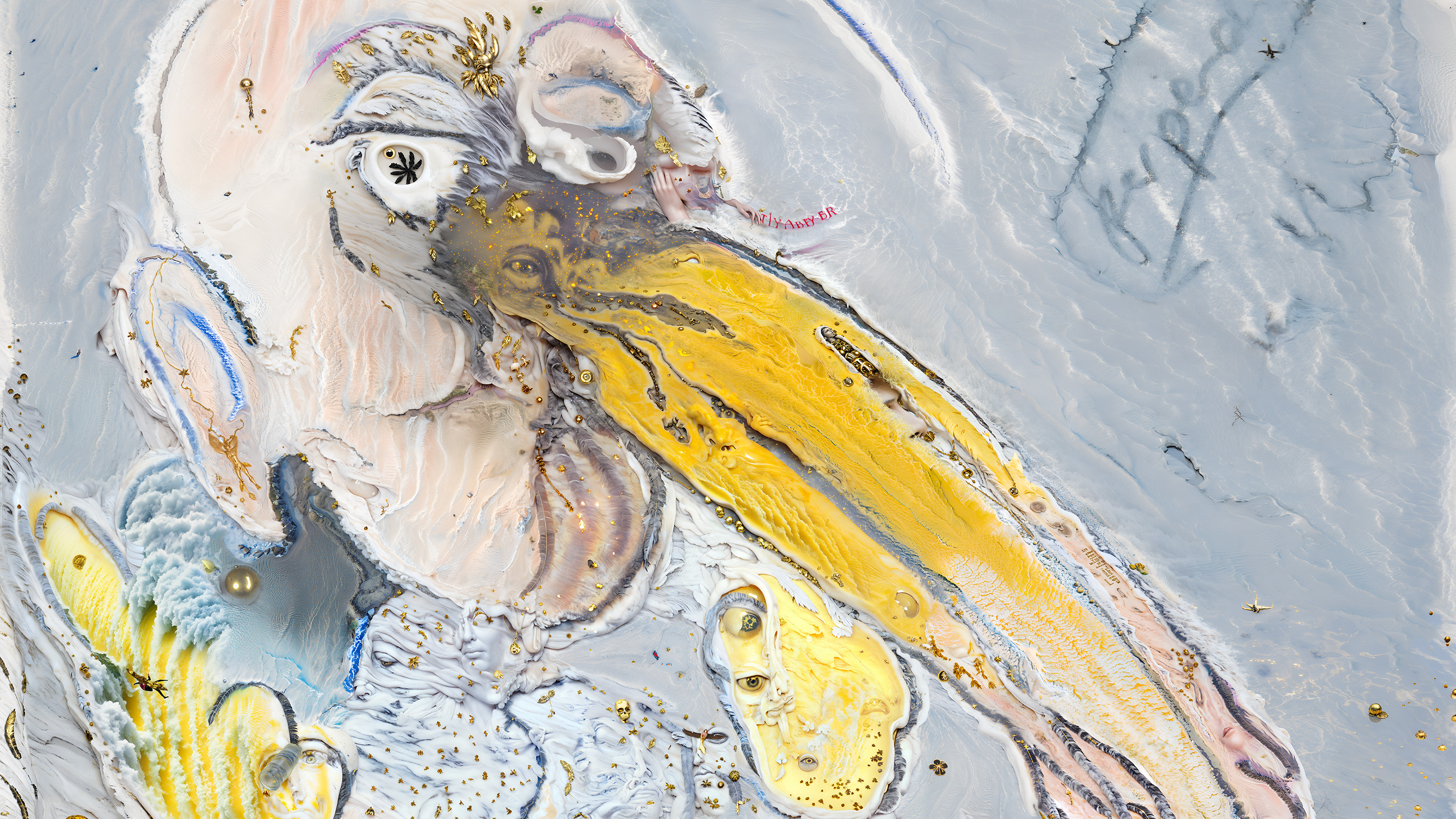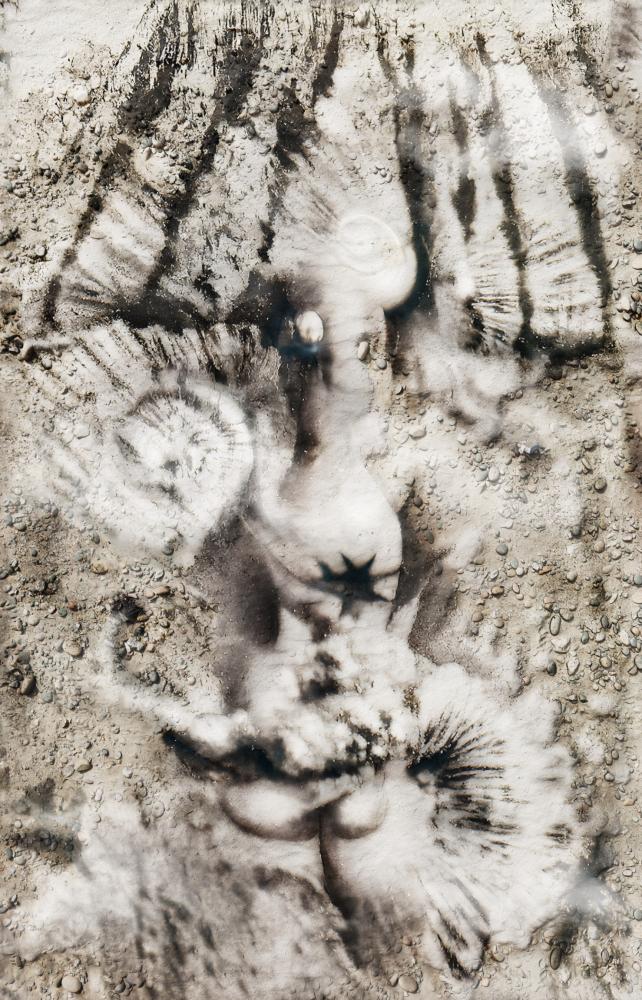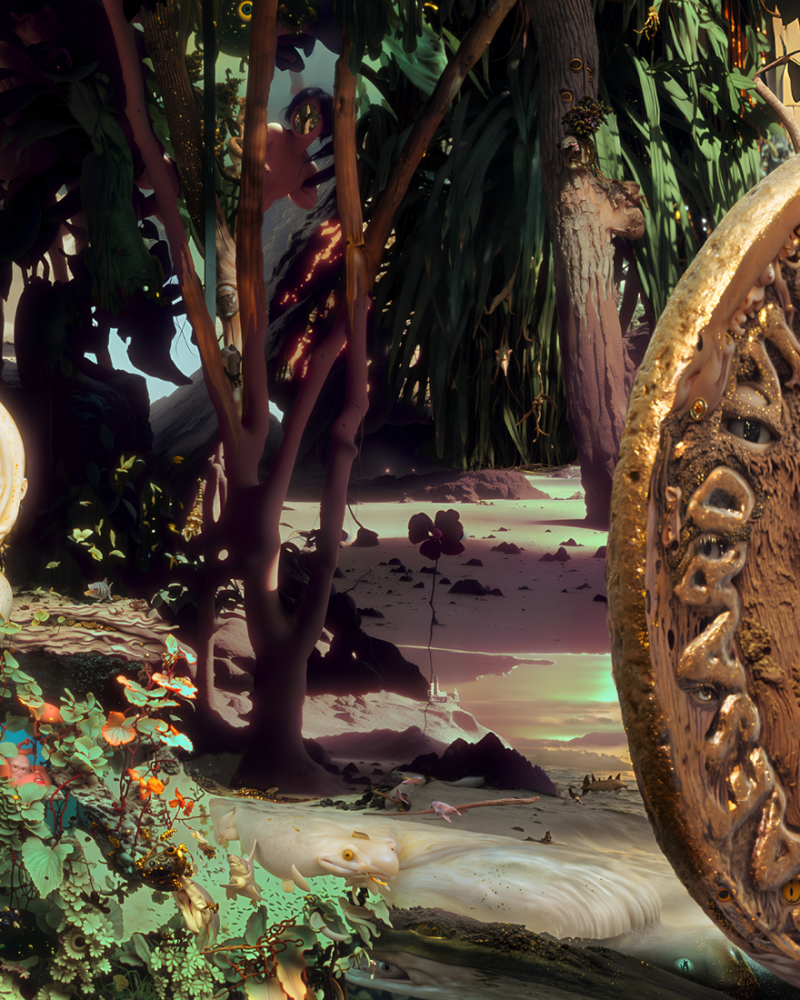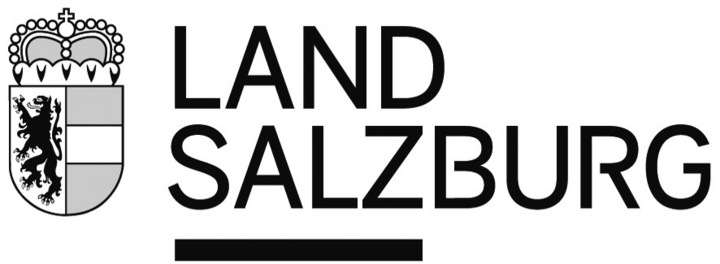



Sky breaking, clouds falling,
Hesitant rain.
The musty smell of wet clothes
Permeates the air.
Mold begins to form,
The color is night.
Pathos and Dataplasma intertwine,
Laplace's fiend lurks around.
Draconian claws crackling on foil.
Duotone moonlight smoothing
A pale reflection of his grin.
His twisted eyes are flaunting tears
Of secrets kept and spoken wis.
Shades unfold,
His being spills over his will.
Determinism stands in the rain.
As the light expands through the slit,
The closet creeks.
Next morn, a desert:
The hanging cloth dries
In the solar gaze.
The closet is closed from within.
We laugh together,
Two flies on a score.
The artist duo Hedda Roman presents an immersive and energetic collaboration in the form of media-based art. Hedda Roman work with new, sophisticated image-generating tools and AI technology to make art installations. A few versions of this artwork are presented in this exhibition. Through the use of algorithms, avatars, artificial intelligence and photography, video and sculpture, the artist duo transposes and extends the immediate but cerebral quality of cinematic storytelling. Their work already embodies the impact of future technologies and is now on view in the form of this large-scale installation.
The artists employ, manipulate, extend, alter and consistently redeploy AI, CGI and other software technologies in combination with inputted texts, photography, video, sculpture, performance, drawing and other media to create images that arise out of these multiplicities. In other words, their artwork is an intimate and conscious collaboration with AI technology and not simply enabling this technology to create images. What emerges is a shared hallucination of images and forms that are at once confusing and spell-binding. The artists describe this almost as a display or revealing of the potential of an unconscious that is simultaneously both human and non-human, with emotional and potential references that we may sense on the one hand, and a complex machinery that simply works away with a universe of possibilities on the other hand. The artists also describe this as an embrace of randomness and non-intentionality, as there is a sense of arbitrariness in each artwork—that which we see reflected in the universe of images that infest social media for example. This is in deep contrast to the common forms of intentionality and control in art making practice, whether painting, photography or other genres. The technical process to produce these images is itself highly complex and comes out of years of research and hard work. It is always also evolving and becoming more complex as both media technologies and AI evolve.
The artists prefer to refer to such tools as Alien Artifact or Savant instead of using the term “Artificial Intelligence.” These models are based on a learned representation of image-text relationships, rather than a true understanding of the underlying concepts of words and images. These artificial processes are intertwined with and dependent on the artists’ input data, ideas, and vision. The artists have re-trained them, and fine-tuned the models using their own custom image collection.
Hedda Roman view these tools as an expression of the present moment, as well as a new material to experiment with. This material is made of emotional connections of the human mind with statistical, nonhuman collections of complex image and language data sourced from the internet. This new form of visualization, aided by these alien tools, adds an unprecedented level of image and information production to a world that is already saturated with visual stimuli.
The artists have thus produced and printed images that are partly manifested by this technology. These images are presented next to monitors, which display constantly shifting images based on a certain archetype of image to highlight the process or “Genese” of the AI Alien Artefact Dreamset. One series of works, Archetypes, which is scattered throughout the exhibition on equal-sized monitors, begins with symbols of different ideas made by the artists that have been inputted into AI technology. After a complex interplay by the artists with these technologies - an interplay that is highly complex and technical and should be explained by the artists themselves—a series of images are produced. An infinite number of images could have actually arisen, but here a limit of images is imposed. This uncanny, fantastic artwork is really at the edge of innovation in that manner.
The artists reach out to an “alien hand” to enhance what is initiated by the human mind through the algorithmic mimesis of such a “mind.” The challenge is to create something that confronts the noise of the world’s endless information, without succumbing to fatalism. The human mind is still the initiator and the humanoid mimesis of the mind is the material. The artists have also previously created a fictional persona and online avatar, “Oldboy.” The audience will hear this figure speak in strange poems once in a while throughout the exhibition.
Another video installation “Light-field Memories: Torso,” is a 3D video inspired by Rilke's poem “Archaischer Torso Apollos.” This piece is a culmination of the flipping coin theme that pervades the video installation and printed images, reflecting our probabilistic era where AI oracles play a role and raise questions about the problem of self-fulfilling prophecy. The piece is a unique visual experience, exclusively created for viewing on a light-field monitor. The monitor emits pixels with directional information, allowing the images and animations to be viewed in 3D without the need for special glasses. The looped sequence invites the viewer to explore the image from different angles, providing an immersive and interactive experience.
Hedda Schattanik (b. 1992 in Westerstede) and Roman Szczesny (b. 1987 in Bensberg) interweave cinematographic elements with surreal animation, literature, drama, sculpture, photography and drawing in video installations. Both artists graduated from the Düsseldorfer Kunstakademie and have been working together since 2014. They live and work in Düsseldorf.
Their main artistic practice expands the traditional boundaries of art-making, while reflecting the perceptions, preconceptions and contradictions which characterize our existence in the world. A dreamlike narrative seems to be the backdrop of each of their art works. While the observer tries to understand the logic behind the opulence of each image, all that remains is the intensity of each individual moment that questions human identity.

































